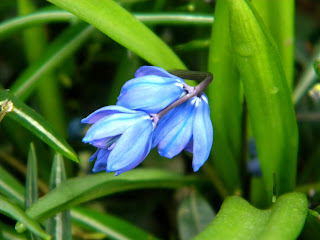Scilla is the old Greek name meaning, / injure; referring, it is
supposed, to the jwisonous bulbs.
Scillas form a group of early-flowering bulbous plants. One of the best is Scilla sibirica, native to Russia, Siberia, and Asia Minor. March.
Leaves.—Two to four, narrow, ascending, four to six inches long. Flowers.—Deep-blue in the type, borne on one to three-flowered scapes, horizontal or drooping.
Perianth.—Of six distinct segments. Stamens.—Six with flattened filaments and oblong anthers.
Ovary.—Three-lobed; style slender, stigma minute.
Capsule.—Triangular, three-valved; seeds black.
Of this group of bright little flowers, Scilla sibirica has become a garden favorite. Its blue stars come early, usually in March, and they are wholly, delightfully, persistently blue. The perianth is about an inch across, pure blue, with a darker line in the. middle of each petal; the stamens are blue; the style and stigma are blue; only the green ovary lies in the centre. It should be planted in mass, fcr only by numbers can the best effects be produced.
A number of species are in cultivation; among the best are bifblui, which can be had in several colors; amd-na, very hardy and robust; virna, a native of sea-shores, and autumnalis, blooming in September.
Image License: I, (sookietex) the creator of this work, hereby release it into the public domain. This applies worldwide. In case this is not legally possible, I grant any entity the right to use this work for any purpose, without any conditions, unless such conditions are required by law.
If These image is subject to copyright in your jurisdiction, i (sookietex) the copyright holder have irrevocably released all rights to it, allowing it to be freely reproduced, distributed, transmitted, used, modified, built upon, or otherwise exploited in any way by anyone for any purpose, commercial or non-commercial, with or without attribution of the author, as if in the public domain.
TEXT CREDIT: Our garden flowers: a popular study of their native lands, their life histories,and their structural affiliations















No comments:
Post a Comment